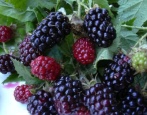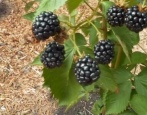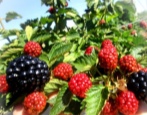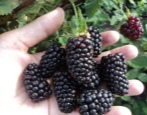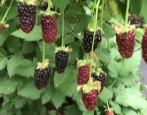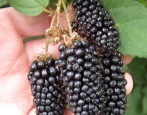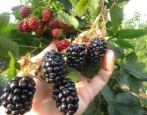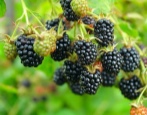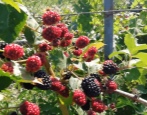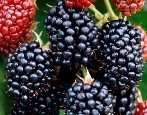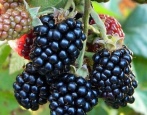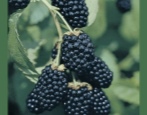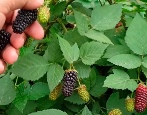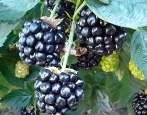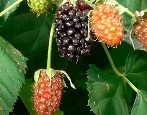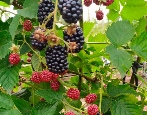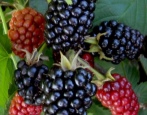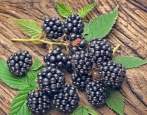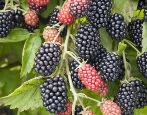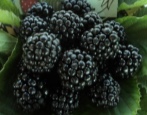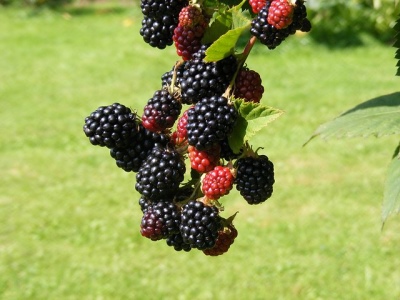
- Authors: USA, Arkansas
- Taste: sweet, balanced, slightly sour
- The presence of thorns: No
- Tasting assessment: 4,6
- Berry weight, g: 7-9
- Berry size: large
- Berry color: bluish black
- Fruiting period: from mid-July, lasts 4-5 weeks
- Yield: 4-5 kg per bush
- Frost resistance, ° C / Winter hardiness: winter hardy, up to -20 С
The Apache blackberry has been known for quite some time. But for many gardeners it is very useful to find out the basic nuances about her and about her cultivation. It is also worth paying attention to the ripening period.
Breeding history of the variety
The culture appeared in 1988. Then American breeders managed to cross the Navajo variety, which was then a star in the blackberry world, and an experimental hybrid, which did not even have a name, but only had the conditional Ark index. 1007. The developers have managed to achieve the ideal balance of genetic traits. Both ancestors were surpassed in such important parameters as the size of the berries and the quality of the fruit.
The foreign counterpart of the name is Apache.
Description of the variety
Quite a powerful plant with erect, vigorous shoots that do not have thorns. The height of the bush varies from 2-2.5 to 3 m. The leaves are green, three-lobed. The flowers are white, the diameter is 4 cm.
Ripening terms
The harvest is ripe from mid-July. The harvest time takes 4 to 6 weeks. Therefore, the culture is classified as late (compared to other types of blackberries).
Yield
Suppliers of planting material claim that the plant is capable of producing at least 4 kg per bush. Under favorable conditions, this figure reaches 5 kg. There are no particular problems with achieving such parameters.
Berries and their taste
The bluish-black Apache berries look very attractive. They have a sweet taste with a good balance. Oval fruits are close to a cone in shape. Their pulp is juicy and slightly sour. The berry weighs from 7 to 9 g, they are usually assigned a tasting rating of 4.6 points.
Growing features
The best time to disembark in the southern regions is autumn (before early October). In places with colder climates and frosts down to -15 ° C, only spring planting (March) is recommended.
Site selection and soil preparation
Apaches develop ideally in partial shade. Sometimes areas shaded with agrofibre or other nets are allowed, but this is rather a half-measure. The distance between individual shrubs should be 1-1.5 m. The gap in a large row can increase to 1.7-2.5 m. You will definitely need to mulch the root zone with a layer of at least 0.1 m.
Pruning
It always starts with the formation of bushes. Basically, blackberries are shaped so that they can be easily removed for the winter. We are talking about pinching at the level of 0.4-0.45 m on vertical shoots. Then the branches must be run horizontally along the trellis. The annual cut allows you to remove the stopped fruiting and deformed shoots; clever pruning guarantees excellent yields even in limited areas.
Watering and feeding
With a lack of natural rainfall, Apache blackberries need to be irrigated during flowering. The same applies to the moment of ovary formation and intensive berry formation. In the southern regions of Russia, drip irrigation is advisable. The best option for organizing it is to use polypropylene pipes. Top dressing, if the blackberry was fed during planting, is carried out again in the second or third year as needed.
In the spring, a bucket (10 kg) is added to the soil for 1 plant:
peat;
humus;
compost.
Frost resistance and preparation for winter
The Apache blackberry is able to survive winter colds down to -20 degrees. But since they may be even stronger, it is better to play it safe. There is no need for shelter only on the Black Sea coast. In all other areas, even in the vicinity of Stavropol, it is mandatory. You can cover the bush with agrofibre, cardboard, and even just straw.
Diseases and pests
You can use the Apache variety with almost no fear of being affected by diseases, including rust and anthracnose. However, one must beware of excessive moisture. It can lead to the formation of gray mold. The methods of control are the same as for the defeat of other varieties of blackberries. It is worth noting that the final biological resistance of the culture to pests and diseases has not yet been fully investigated, and therefore any gardener should be mentally prepared for unexpected surprises.
Reproduction
For this purpose, both root suckers and the tops of the shoots are useful. But young seedlings will need to be thoroughly protected from drafts, which can destroy immature shoots. You also need to constantly monitor whether the landing hole dries up. "Heteroauxin" and "Kornevin" help to improve rooting. The advantage of Apache is the increased survival rate of cuttings in comparison with other varieties devoid of thorns.
